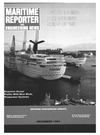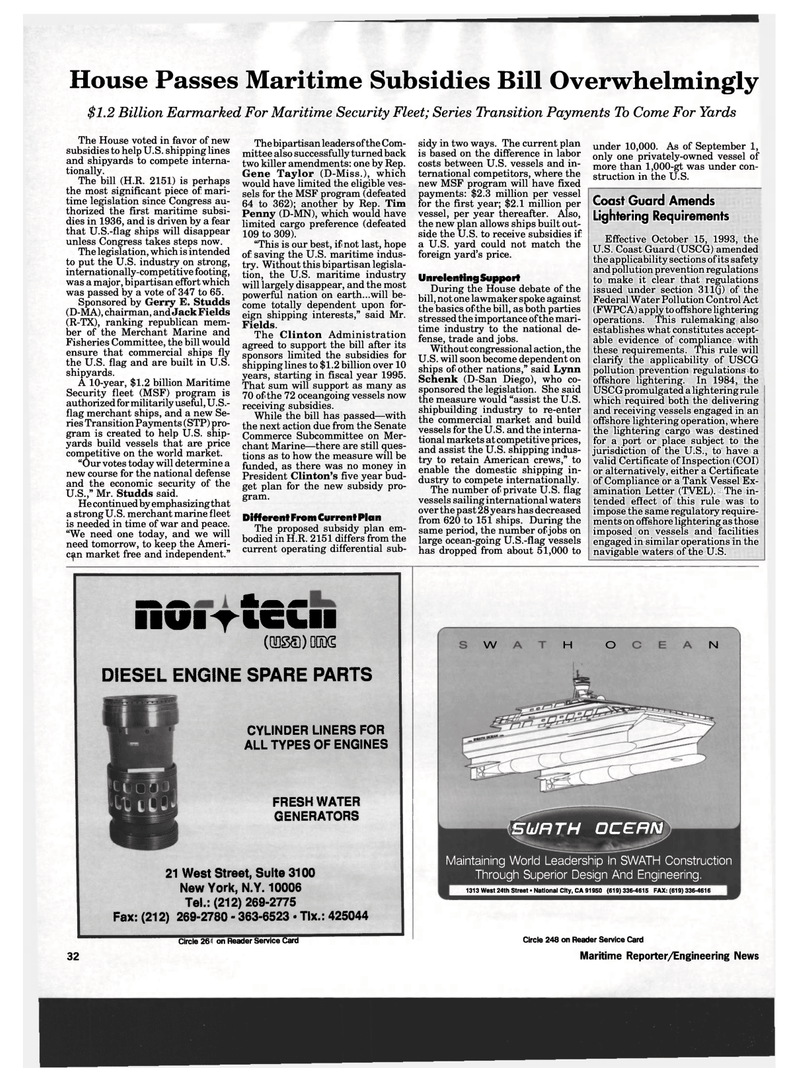
Page 30: of Maritime Reporter Magazine (December 1993)
Read this page in Pdf, Flash or Html5 edition of December 1993 Maritime Reporter Magazine
House Passes Maritime Subsidies Bill Overwhelmingly $1.2 Billion Earmarked For Maritime Security Fleet; Series Transition Payments To Come For Yards
The House voted in favor of new subsidies to help U.S. shipping lines and shipyards to compete interna- tionally.
The bill (H.R. 2151) is perhaps the most significant piece of mari- time legislation since Congress au- thorized the first maritime subsi- dies in 1936, and is driven by a fear that U.S.-flag ships will disappear unless Congress takes steps now.
The legislation, which is intended to put the U.S. industry on strong, internationally-competitive footing, was a major, bipartisan effort which was passed by a vote of 347 to 65.
Sponsored by Gerry E. Studds (D-MA), chairman, and JackFields (R-TX), ranking republican mem- ber of the Merchant Marine and
Fisheries Committee, the bill would ensure that commercial ships fly the U.S. flag and are built in U.S. shipyards.
A 10-year, $1.2 billion Maritime
Security fleet (MSF) program is authorized for militarily useful, U.S.- flag merchant ships, and a new Se- ries Transition Payments (STP) pro- gram is created to help U.S. ship- yards build vessels that are price competitive on the world market. "Our votes today will determine a new course for the national defense and the economic security of the
U.S.," Mr. Studds said.
He continued by emphasizing that a strong U.S. merchant marine fleet is needed in time of war and peace. "We need one today, and we will need tomorrow, to keep the Ameri- can market free and independent."
The bipartisan leaders of the Com- mittee also successfully turned back two killer amendments: one by Rep.
Gene Taylor (D-Miss.), which would have limited the eligible ves- sels for the MSF program (defeated 64 to 362); another by Rep. Tim
Penny (D-MN), which would have limited cargo preference (defeated 109 to 309). "This is our best, if not last, hope of saving the U.S. maritime indus- try. Without this bipartisan legisla- tion, the U.S. maritime industry will largely disappear, and the most powerful nation on earth...will be- come totally dependent upon for- eign shipping interests," said Mr.
Fields.
The Clinton Administration agreed to support the bill after its sponsors limited the subsidies for shipping lines to $ 1.2 billion over 10 years, starting in fiscal year 1995.
That sum will support as many as 70 of the 72 oceangoing vessels now receiving subsidies.
While the bill has passed—with the next action due from the Senate
Commerce Subcommittee on Mer- chant Marine—there are still ques- tions as to how the measure will be funded, as there was no money in
President Clinton's five year bud- get plan for the new subsidy pro- gram.
Different From Current Plan
The proposed subsidy plan em- bodied in H.R. 2151 differs from the current operating differential sub- sidy in two ways. The current plan is based on the difference in labor costs between U.S. vessels and in- ternational competitors, where the new MSF program will have fixed payments: $2.3 million per vessel for the first year; $2.1 million per vessel, per year thereafter. Also, the new plan allows ships built out- side the U.S. to receive subsidies if a U.S. yard could not match the foreign yard's price.
Unrelenting Support
During the House debate of the bill, not one lawmaker spoke against the basics of the bill, as both parties stressed the importance of the mari- time industry to the national de- fense, trade and jobs.
Without congressional action, the
U.S. will soon become dependent on ships of other nations," said Lynn
Schenk (D-San Diego), who co- sponsored the legislation. She said the measure would "assist the U.S. shipbuilding industry to re-enter the commercial market and build vessels for the U.S. and the interna- tional markets at competitive prices, and assist the U.S. shipping indus- try to retain American crews," to enable the domestic shipping in- dustry to compete internationally.
The number of private U.S. flag vessels sailing international waters over the past 28 years has decreased from 620 to 151 ships. During the same period, the number of jobs on large ocean-going U.S.-flag vessels has dropped from about 51,000 to under 10,000. As of September 1, only one privately-owned vessel of more than 1,000-gt was under con- struction in the U.S.
Coast Guard Amends
Lightering Requirements
Effective October 15, 1993, the
U.S. Coast Guard (USCG) amended the applicability sections of its safety and pollution prevention regulations to make it clear that regulations issued under section 31lQ) of the
Federal Water Pollution Control Act (FWPC A) apply to offshore lightering operations. This rulemaking also establishes what constitutes accept- able evidence of compliance with these requirements. This rule will clarify the applicability of USCG pollution prevention regulations to offshore lightering. In 1984, the
USCG promulgated a lightering rule which required both the delivering and receiving vessels engaged in an offshore lightering operation, where the lightering cargo was destined for a port or place subject to the jurisdiction of the U.S., to have a valid Certificate of Inspection (COI) or alternatively, either a Certificate of Compliance or a Tank Vessel Ex- amination Letter (TVEL). The in- tended effect of this rule was to impose the same regulatory require- ments on offshore lightering as those imposed on vessels and facilities engaged in similar operations in the navigable waters of the U.S. iiSittiiii (QDSa)OOQS
DIESEL ENGINE SPARE PARTS
CYLINDER LINERS FOR
ALL TYPES OF ENGINES
FRESH WATER
GENERATORS 21 West Street, Suite 3100
New York, N.Y. 10006
Tel.: (212) 269-2775
Fax: (212) 269-2780 • 363-6523 • Tlx.: 425044 w H O N
SURTH OCERN
Maintaining World Leadership In SWATH Construction
Through Superior Design And Engineering. 1313 West 24th Street • National City, CA 91950 (619) 336-4615 FAX: (619) 336-4616 32
Circle 206 on Reader Service Card Circle 248 on Reader Service Card
Maritime Reporter/Engineering News

 29
29

 31
31
